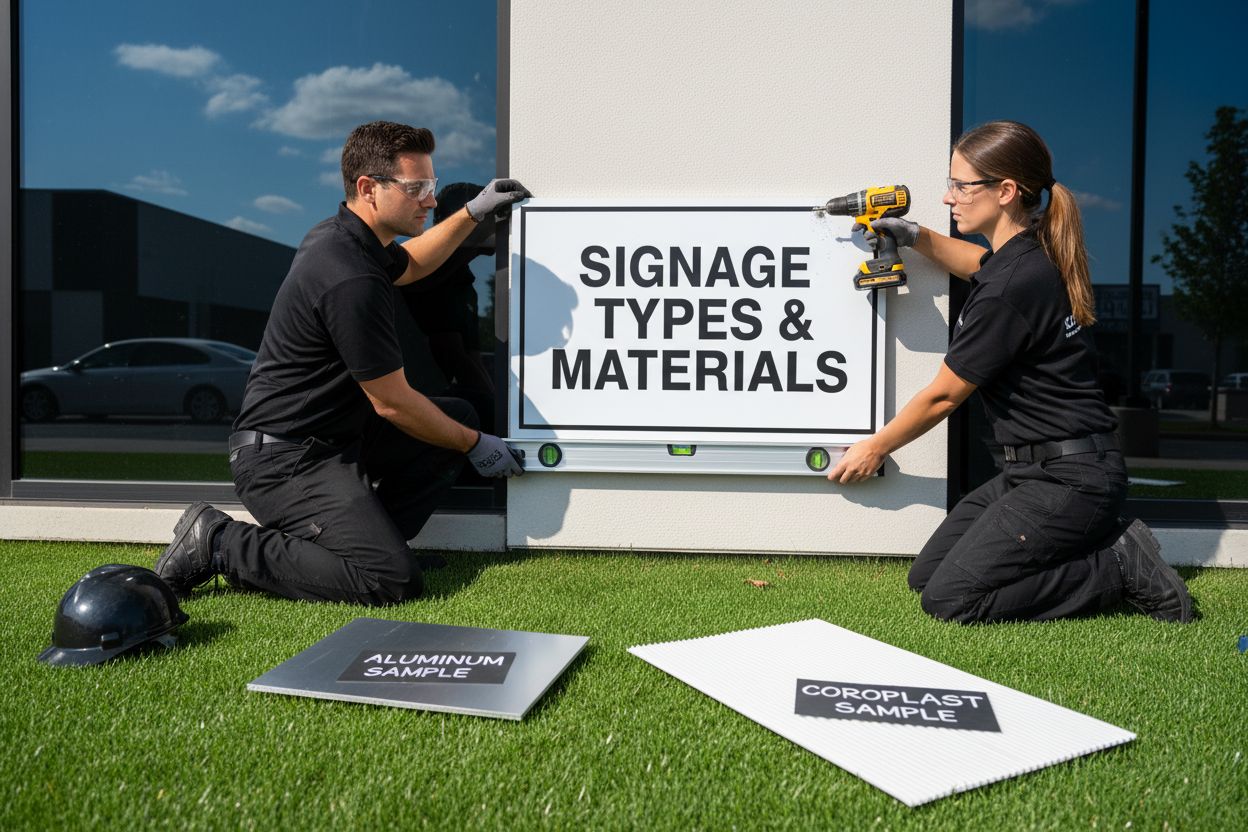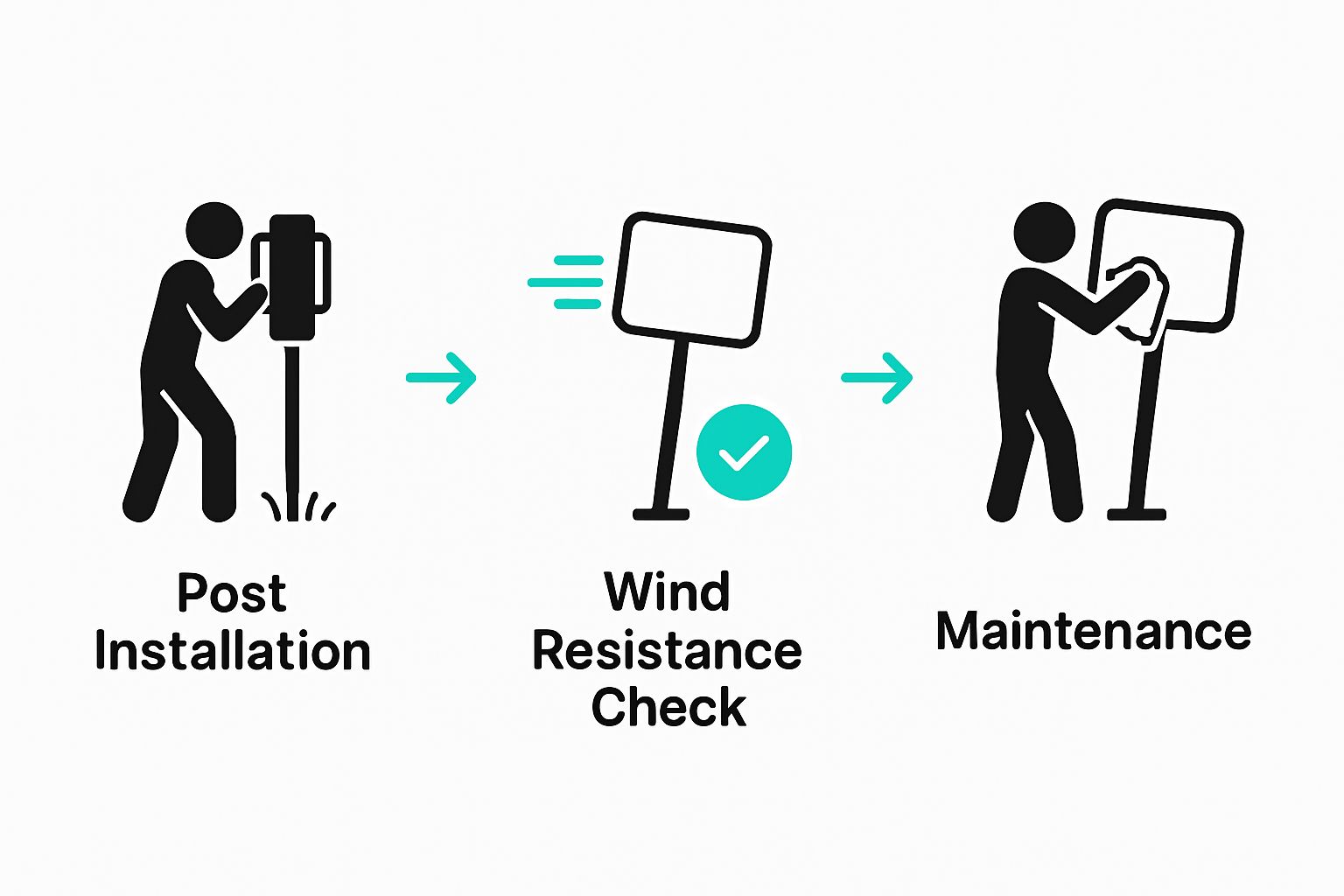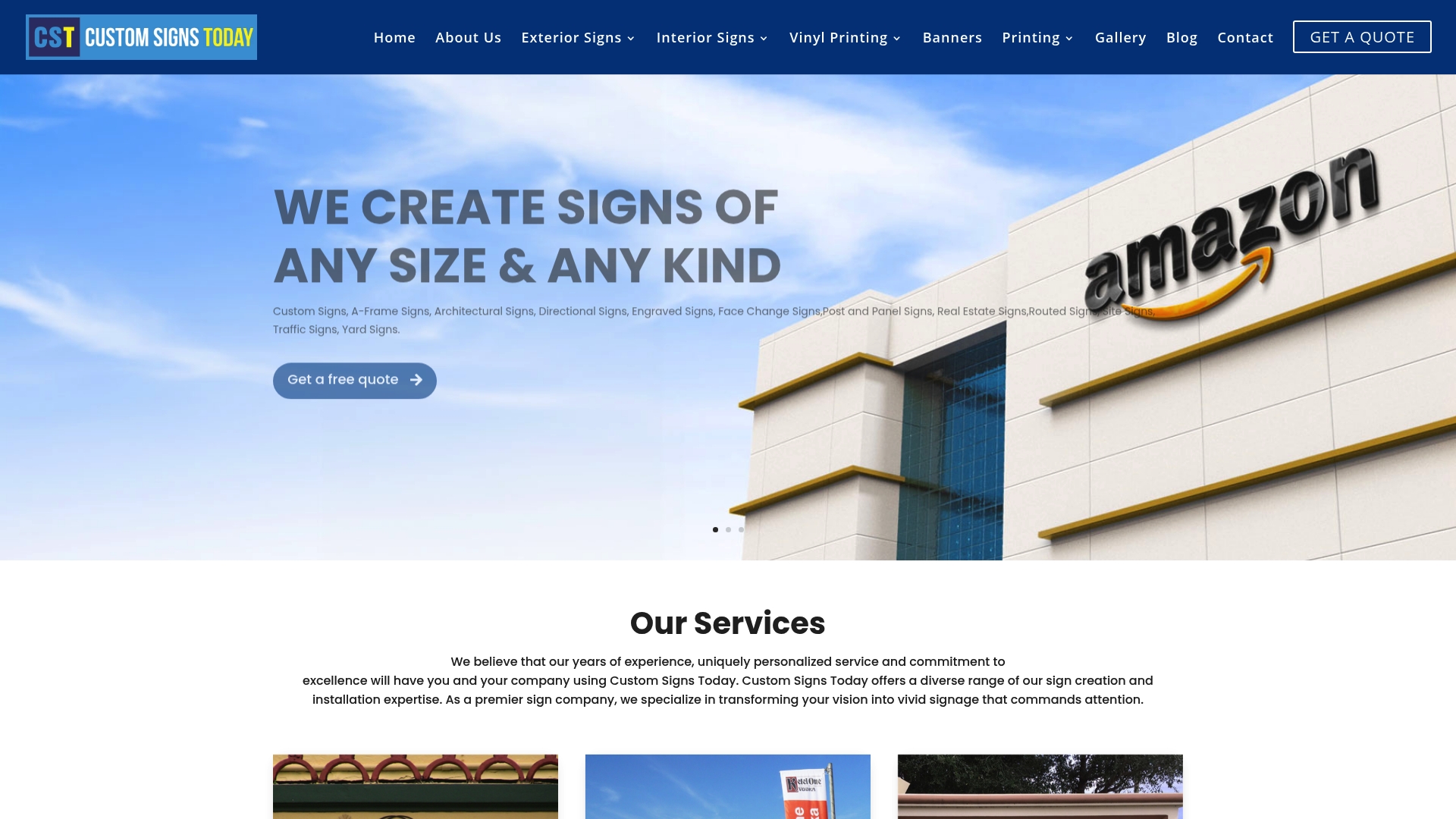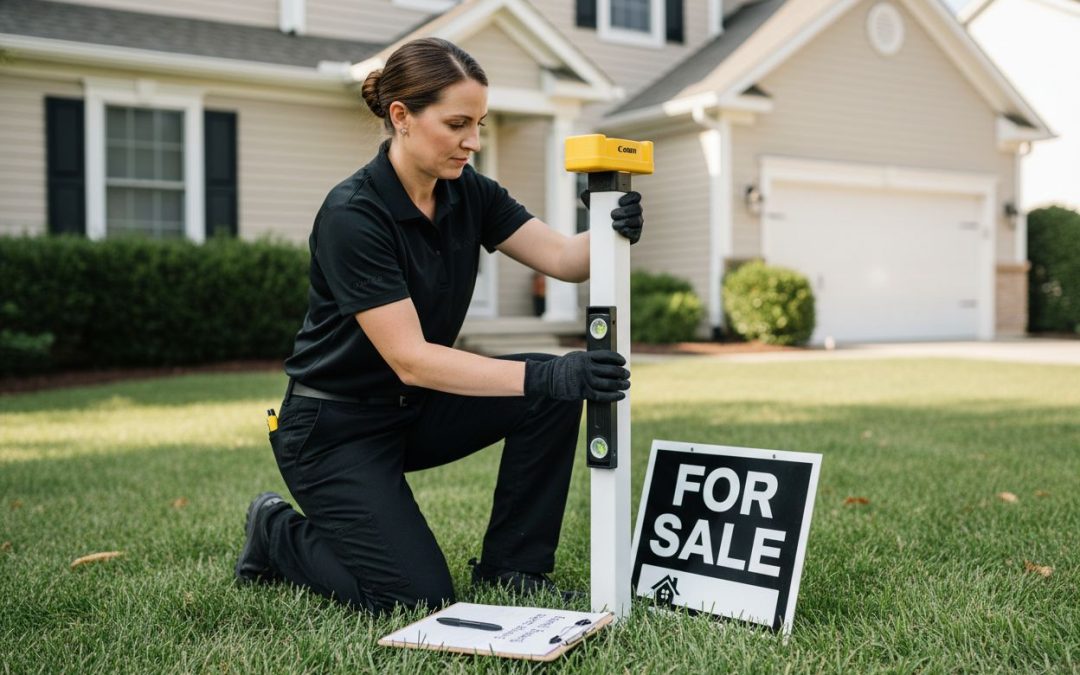Real estate signs are everywhere and you probably walk or drive past dozens each week. But most get ignored. Here’s something wild: signs that use precise audience targeting and professional design can cause property inquiries to spike far above average. The surprise is that it’s not always the biggest or fanciest sign that wins attention. The real shift comes from strategy—knowing who you want to reach and how to turn a simple display into a lead magnet. That changes everything.
Table of Contents
- Step 1: Define Your Target Audience And Goals
- Step 2: Choose The Right Signage Types And Materials
- Step 3: Design Your Sign With Professional Quality
- Step 4: Select Optimal Locations For Sign Placement
- Step 5: Install And Maintain Your Real Estate Signs
Quick Summary
| Key Point | Explanation |
|---|---|
| 1. Define audience and goals | Identify who will see your signs and the outcomes you wish to achieve to tailor your signage strategy effectively. |
| 2. Choose appropriate materials | Select durable materials that withstand weather conditions and enhance visibility for your real estate signs. |
| 3. Design for professional quality | Create visually appealing signs with clear information to establish credibility and attract potential clients. |
| 4. Strategically place signs | Analyze visibility factors and local regulations to position your signs where they will engage the most viewers. |
| 5. Ensure installation and maintenance | Properly install and regularly maintain signs to preserve professionalism and information clarity. |
Step 1: Define Your Target Audience and Goals
Successful real estate signage begins with crystal clear strategic planning. Understanding exactly who will see your signs and what specific outcomes you want to achieve determines the entire design and placement approach. Your signage strategy must connect directly with your intended audience, whether that means potential home buyers, property investors, or local community members.
Real estate signage is more than just displaying information. Precise audience targeting transforms a simple sign into a powerful communication tool. Start by conducting thorough market research within your specific geographic area. Consider demographic factors like age ranges, income levels, professional backgrounds, and local community characteristics that might influence property interest.
When defining your goals, break them down into measurable objectives. Are you aiming to generate immediate property inquiries? Create brand awareness for your real estate agency? Drive potential buyers to an online listing? Each goal requires a nuanced approach in sign design, messaging, and placement. For instance, signs targeting first time homebuyers will look dramatically different from those appealing to commercial real estate investors.
To effectively map your audience and objectives, create a detailed profile that includes key characteristics. Picture your ideal viewer: What motivates them? What information do they most want to see? What visual elements will capture their attention quickly? A sign targeting young professionals might emphasize modern design and technological contact methods, while a sign for luxury property markets would prioritize sophisticated typography and minimal, elegant information presentation.
Consider practical verification methods to ensure your signage strategy works. Track metrics like phone call inquiries, website visits from QR codes, or direct contact requests generated from your signs. These data points help you refine future signage approaches and understand which design elements truly resonate with your target demographic.
Remember that your real estate signage is often a potential client’s first interaction with your brand. Make every visual element count by aligning design, messaging, and placement with the specific audience you want to attract. A meticulously crafted sign does more than provide information – it tells a story and creates an emotional connection that can transform casual interest into genuine property engagement.
Step 2: Choose the Right Signage Types and Materials
Selecting the appropriate signage type and material is crucial for creating impactful real estate communication that withstands environmental challenges and captures potential buyers’ attention. Material selection directly influences your sign’s durability, visibility, and overall marketing effectiveness. Real estate professionals must consider multiple factors when choosing signage, including location, climate conditions, budget, and specific marketing objectives.
Outdoor real estate signs demand robust materials that can endure varying weather conditions. Aluminum and coroplast represent two primary options for professional signage. Aluminum offers exceptional longevity and resists rust, making it ideal for long term property listings or permanent location markers. Coroplast provides a lightweight, cost effective alternative perfect for temporary signs or shorter marketing campaigns. Learn more about exterior sign options to understand the nuanced differences between material choices.
Beyond material selection, sign type plays a significant role in your marketing strategy. Yard signs work brilliantly for residential property sales, offering immediate neighborhood visibility. Larger real estate development signs communicate broader project details for commercial or multi unit properties. Magnetic vehicle signs provide mobile advertising opportunities, transforming personal or professional vehicles into marketing platforms.
Consider environmental factors meticulously when selecting materials. Signs in coastal areas require marine grade materials resistant to salt corrosion. Urban environments might necessitate anti graffiti coatings. Signs exposed to intense sunlight need UV resistant printing and materials that prevent color fading. Professional grade materials protect your investment and maintain a polished, credible brand image.
Economic considerations should balance with quality requirements. While cheaper materials might seem attractive initially, investing in higher quality signage reduces long term replacement costs. Premium materials communicate professionalism and commitment to potential clients. Consider your sign as a direct reflection of your real estate brand quality.
To verify your material and signage type selection, conduct a comprehensive assessment. Test potential sign materials against local climate conditions. Request material samples from manufacturers. Photograph test signs in various lighting conditions to ensure readability and visual appeal.
The following table compares commonly used real estate sign materials and types mentioned in the article to help you identify which options best align with your property needs, environmental conditions, and marketing strategies.
| Sign Material/Type | Durability | Ideal Use Case | Key Benefits |
|---|---|---|---|
| Aluminum | High | Long-term, outdoor or permanent signs | Resists rust, durable in harsh weather |
| Coroplast | Moderate | Temporary campaigns, short-term listings | Lightweight, cost effective, easy to install |
| Yard Signs | Varies (based on material) | Residential properties, visible neighborhood marketing | Immediate visibility, quick installation |
| Development Signs | High | Large commercial or multi-unit properties | Showcases project details, high-impact visibility |
| Magnetic Vehicle Signs | Moderate | Mobile advertising on vehicles | Moveable, transforms vehicle into a marketing tool |
| By meticulously evaluating these elements, you transform a simple sign into a powerful marketing tool that attracts and engages potential property buyers. |

Step 3: Design Your Sign with Professional Quality
Designing a professional real estate sign transforms basic information into a compelling visual communication tool. Professional design communicates credibility, attracts potential clients, and sets your property marketing apart from competitors. The visual elements of your sign serve as a critical first impression that can significantly influence viewer perception and engagement.
Begin by establishing a clear visual hierarchy that guides the viewer’s eye through the most important information. Your sign should prioritize key details like property address, contact information, and primary selling points. Use font sizes strategically – contact details should be large and easily readable from a distance, while secondary information remains smaller but still legible. Typography plays a crucial role in professional design, so select clean, modern fonts that align with your brand identity.
Color selection requires careful consideration beyond aesthetic preferences. Choose color combinations that provide maximum contrast and readability. Dark text on light backgrounds or vice versa ensures visibility from various distances and lighting conditions. Professional real estate signs typically utilize neutral color palettes with strategic accent colors that draw attention without appearing overwhelming. Explore our yard sign design tips to understand how color and layout work together to create impact.
Incorporate high quality graphics and logos that represent your real estate brand professionally. Avoid cluttering the sign with excessive information. The most effective signs communicate essential details quickly and cleanly. Include your agency logo, a professional headshot if appropriate, and contact methods like phone number and website. QR codes can provide an innovative way to link physical signage with digital property information, allowing potential buyers instant access to detailed listings.
Consider the viewing environment when designing your sign. Signs must be legible from different angles and distances. Test your design by viewing mockups from various perspectives and lighting conditions. Print multiple drafts and evaluate them in real world settings. Professional designers recommend creating visual mock ups that simulate actual sign placement to identify potential readability issues.
To verify design quality, gather feedback from colleagues and potential target clients. Ask them to review your sign design and provide honest assessments about readability, visual appeal, and information clarity. A truly professional sign communicates information effectively while maintaining a visually appealing and memorable aesthetic that represents your real estate brand with sophistication and confidence.
Step 4: Select Optimal Locations for Sign Placement
Successful real estate signage relies as much on strategic placement as on design quality. Location determines visibility, reach, and potential buyer engagement. Your sign placement strategy should transform passive marketing into an active communication channel that captures attention and drives interest.
Start by conducting a comprehensive site analysis that considers multiple visibility factors. Examine traffic patterns, pedestrian and vehicle flow, and natural sight lines that maximize potential viewer exposure. High traffic intersections, areas with consistent foot traffic, and locations with clear sightlines provide optimal placement opportunities. Learn more about directional sign strategies to understand how strategic positioning amplifies marketing effectiveness.
Local regulations play a critical role in sign placement. Before installing any sign, research municipal zoning laws, homeowners association guidelines, and property specific restrictions. Some areas have strict rules about sign dimensions, placement distances from property lines, and duration of display. Obtaining necessary permits prevents potential legal complications and ensures your signage remains compliant with local ordinances.
Consider the psychological impact of sign placement. Signs positioned at eye level with clear backgrounds create more engaging visual experiences. Avoid locations with excessive visual clutter or competing signage that might diminish your message. Corners of properties, areas near main entrances, and spots with unobstructed views work best for maximizing visibility and impact.
Property type influences optimal placement strategies. Residential listings benefit from yard signs positioned near street frontage, while commercial properties might require larger signs visible from multiple angles. Urban environments demand different approaches compared to suburban or rural settings. Adjust your placement strategy to match the specific characteristics of your target location.
Verify your placement strategy by conducting physical tests. Walk or drive by the proposed sign location at different times of day. Assess visibility from various angles and distances. Take photographs to understand how the sign appears in different lighting conditions and environmental contexts. A sign that looks perfect during midday might become unreadable during early morning or evening hours.
Remember that sign placement is both an art and a science. Your goal is to create a strategic visual communication point that seamlessly integrates with the surrounding environment while capturing potential buyers’ attention. Thoughtful, purposeful placement transforms a simple sign into a powerful marketing tool that drives real estate engagement.
Step 5: Install and Maintain Your Real Estate Signs
Installation and ongoing maintenance represent the final critical stages in creating impactful real estate signage. Proper installation ensures your sign communicates effectively while maintaining professional appearance and durability. Your sign’s longevity and performance depend directly on meticulous installation techniques and consistent maintenance practices.
Begin with gathering essential installation tools before starting the process. You will need a post driver or sturdy hammer, measuring tape, level, weather resistant screws or stakes, and protective gloves. Explore our realtor sign installation guide to understand specific requirements for different sign types. Precise measurements are crucial – your sign must be positioned exactly perpendicular to the ground, with consistent height and alignment to maintain a professional appearance.
Ground conditions significantly impact sign stability, so assess the installation surface carefully. Soft soil requires deeper stake insertion, while rocky terrain might necessitate alternative mounting methods. For yard signs, drive stakes at least 12 inches deep to ensure wind resistance. Commercial property signs often require more complex mounting solutions, potentially involving concrete anchoring or specialized mounting brackets.
Weather protection represents an ongoing maintenance challenge. Select installation locations that minimize direct exposure to harsh environmental elements. Consider using protective sprays or coatings that enhance sign resilience against UV radiation, moisture, and temperature fluctuations. Regular inspections help identify potential wear and damage before they become significant problems.
Implement a consistent maintenance schedule that includes quarterly inspections. Check for signs of fading, structural damage, loose connections, or accumulated dirt that might reduce visibility. Clean signs using soft cloths and mild, non abrasive cleaning solutions. Avoid harsh chemicals that could damage print quality or material integrity. Replace signs showing significant wear to maintain a professional image.
Verify installation quality through systematic checks. Signs should remain stable during moderate wind conditions, display information clearly from multiple angles, and present a crisp, clean appearance. Take photographs documenting initial installation and subsequent maintenance efforts.
 These records help track sign performance and provide valuable insights for future signage strategies.
These records help track sign performance and provide valuable insights for future signage strategies.
Here is a checklist table summarizing installation and maintenance verification steps to ensure your real estate signage remains professional, stable, and effective over time.
| Verification Step | Description | Frequency |
|---|---|---|
| Proper Alignment | Check signs are perpendicular and level | During installation |
| Ground Stability | Assess soil or mounting conditions for security | During installation |
| Weather Protection | Apply protective sprays/coatings as needed | As required |
| Visibility and Clarity | Confirm information is readable from all angles | After installation |
| Structural Inspection | Look for wear, fading, or loose fasteners | Quarterly |
| Cleaning | Use soft cloths and mild cleaning solutions | Quarterly or as needed |
| Replacement Assessment | Replace signs showing significant damage | As needed |
| Photographic Documentation | Take photos of each installed/maintained sign | After any update or check |
Remember that your real estate sign serves as a silent ambassador for your brand. A well installed and meticulously maintained sign communicates professionalism, attention to detail, and commitment to quality. Treat your signage as an investment in your real estate marketing strategy, deserving consistent care and strategic maintenance.
Take Your Real Estate Signage to the Next Level With Custom Solutions
Have you ever poured time and effort into real estate signs—just to find they blend into the background or fail to generate the response you expect? If you have struggled with targeting the right buyers, choosing long-lasting materials, or ensuring your signs truly reflect your professionalism, you are not alone. The Real Estate Signage Guide: Create Impactful Signs explains how design, materials, and placement shape your results. But getting from research to results requires expert execution.

Partner with Custom Signs Today, your trusted experts in personalized signage. We use only premium, weather-resistant materials and create custom sign solutions that help you stand out in any market. Ready to attract more buyers and boost inquiries? Let our team bring your real estate vision to life by requesting a free quote or discovering our tailored sign and print services right now. Take your first step toward real estate success—contact us today and experience the power of custom signage built just for you.
Frequently Asked Questions
How do I define my target audience for real estate signage?
To define your target audience, start by conducting market research in your specific area. Identify key demographic factors such as age, income, and interests that influence property interest. Create a profile of your ideal viewer to tailor your signage effectively.
What materials are best for outdoor real estate signs?
Outdoor real estate signs should be made from durable materials like aluminum for long-term use or coroplast for temporary signage. Choose materials based on your marketing goals and local weather conditions to ensure longevity and visibility.
How can I design a professional-looking real estate sign?
To design a professional sign, establish a clear visual hierarchy, prioritize key information, and choose readable fonts and contrasting colors. Utilize high-quality graphics and limit clutter to communicate essential details quickly and attractively.
What factors should I consider when placing my real estate signs?
Consider traffic patterns, visibility from various angles, and local regulations when positioning your real estate signs. Choose locations with high foot or vehicle traffic to maximize exposure and ensure compliance with any zoning laws.
How do I install and maintain my real estate signs properly?
To install your signs, gather the necessary tools, ensure proper alignment, and assess ground conditions for stability. Maintain your signs by conducting quarterly inspections, cleaning them regularly, and replacing any that show significant wear. This will help your signs remain effective and professional-looking over time.
What metrics should I track to measure the effectiveness of my signage?
Track metrics such as phone inquiries, website visits via QR codes, or direct contacts generated from your signs. Analyzing these data points will help you refine future signage strategies and understand what designs resonate best with your audience.

